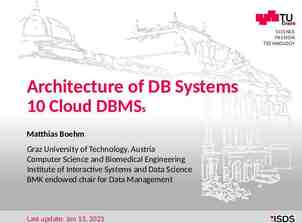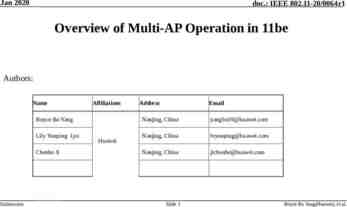Introduction To ITS Prof. Omer Maaitah
49 Slides3.79 MB

Introduction To ITS Prof. Omer Maaitah

Outline Intelligent Transportation Systems ITS Applications – Telematics Telecommunication Infomatics ITS Standard Organization Vehicular communication Telecom Service Integration

Outline Intelligent Transportation Systems ITS Applications – Telematics Telecommunication Infomatics ITS Standard Organization Vehicular communication Telecom Service Integration

Intelligent Transportation System The term intelligent transportation system (ITS) refers to efforts to add information and communications technology to transport infrastructure and vehicles, in order to improve safety and reduce vehicle wear, transportation times, and fuel consumption.

Intelligent Transport Systems ITS are advanced applications which, without embodying intelligence as such, aim to provide innovative services relating to different modes of transport and traffic management and enable various users to be better informed and make safer, more coordinated, and 'smarter' use of transport networks. Interest in ITS comes from the problems caused by traffic congestion and a synergy of new information technology for simulation, real-time control, and communications networks. Traffic congestion has been increasing worldwide as a result of increased motorization, urbanization, population growth, and changes in population density. Congestion reduces efficiency of transportation and increases travel time, air pollution, and fuel consumption

Intelligent transport technologies Intelligent transport systems vary in technologies applied, from basic management systems such as car navigation; traffic signal control systems; container management systems; variable message signs; automatic number plate recognition or speed cameras to monitor applications, such as security CCTV systems; and to more advanced applications that integrate live data and feedback from a number of other sources, such as parking guidance and information systems; weather information; bridge deicing systems; and the like. Additionally, predictive techniques are being developed to allow advanced modeling and comparison with historical baseline data. Some of these technologies are described in the following sections.

Technologie of ITS I Wireless communications: Various forms of wireless communications technologies have been proposed for intelligent transportation systems. 2 Computational technologies: Recent advances in vehicle electronics have led to a move toward fewer, more capable computer processors on a vehicle. A typical vehicle in the early 2000s would have between 20 and 100 individual networked microcontroller/Programmable logic controller modules with non-realtime operating systems 3 Floating car data/floating cellular data: "Floating car" or "probe" data collection is a set of relatively low-cost methods for obtaining travel time and speed data for vehicles traveling along streets, highways, freeways, and other transportation routes. Broadly speaking, three methods have been used to obtain the raw data:

4 Triangulation Method: In developed countries a high proportion of cars contain one or more mobile phones. The phones periodically transmit their presence information to the mobile phone network, even when no voice connection is established 5 Vehicle Re-Identification: Vehicle re-identification methods require sets of detectors mounted along the road. In this technique, a unique serial number for a device in the vehicle is detected at one location and then detected again (re-identified) further down the road 6 GPS Based Methods: An increasing number of vehicles are equipped with in-vehicle GPS (satellite navigation) systems that have two-way communication with a traffic data provider. Position readings from these vehicles are used to compute vehicle speeds

7 Sensing technologies : Technological advances in telecommunications and information technology, coupled with state-of-the-art microchip, RFID (Radio Frequency Identification), and inexpensive intelligent beacon sensing technologies, have enhanced the technical capabilities that will facilitate motorist safety benefits for intelligent transportation systems globally. 8 Bluetooth detection: Bluetooth is an accurate and inexpensive way to measure travel time and make origin/destination analysis. Bluetooth is a wireless standard used to communicate between electronic devices like mobile/smart phones, headsets, navigation systems, computers etc.

Introduction of ITS ITS is. Air-line Information Traffic Information Bus Information .Traffic and Transit Management

Introduction of ITS ITS is. Traffic light control .Traffic Signal Systems

Introduction of ITS ITS is. Locate car’s current position by satellites .Global Positioning Systems

Introduction of ITS ITS is. Weather Information Systems Commercial Vehicle Electronic Clearance Vehicle Electronic Clearance

Introduction of ITS freeway Information ITS is. Navigation Information Bus-stop Information .Real-Time Traveler Information

Why is ITS Important? Offers the next major leap forward in improving safety, convenience, and productivity of our personal and commercial travel. Critical as population and congestion increase, and land and funding for new roads decrease.

How Does ITS Touch YOU?

Identified Benefits Time Savings Improved Throughput Reduced Crashes and Fatalities Cost Avoidance Increased Customer Satisfaction Energy and Environmental Benefits

Outline Intelligent Transportation Systems ITS Applications – Telematics Telecommunication Infomatics ITS Standard Organization Vehicular communication Telecom Service Integration

Applications Overview Global Positioning Systems Weather information systems Bus Information System Traffic and transit management Real-time information Parking Incident management Emergency management Electronic toll collection Commercial vehicle operations

Global Positioning Systems The Global Positioning System (GPS) is a satellite-based navigation system made up of a network of 24 satellites placed into orbit by the U.S. Department of Defense. GPS was originally intended for military applications, but in the 1980s, the government made the system available for civilian use. GPS works in any weather conditions, anywhere in the world, 24 hours a day.

Weather information systems Monitor the weather information

Bus Information System Public Transport Information – Countdown: Real-time Bus Stop Information (London, UK)

Traffic and transit management Traffic Signals Monitoring throughput: - Recommended speeds - Ramp metering Incident Management Signal priority for: - Emergency vehicles - Public transport Ramp metering

Real-time information Automobile traffic Public transport Parking Airport arrivals/departures News, banking, stocks

Parking Information on availability Guidance to: - Available facility - Actual spot

Incident management CCATS & CCIDS: Video-Based Solutions for Data Collection and Incident Detection (Europe)

Emergency management Pre-trip, On-trip, emergency – AA ITS Service (UK) – ADAC ITS Services (Germany)

Electronic toll collection Electronic toll collection (ETC) makes it possible for vehicles to drive through toll gates at traffic speed, reducing congestion at toll plazas and automating toll collection. Originally ETC systems were used to automate toll collection, but more recent innovations have used ETC to enforce congestion pricing through cordon zones in city centers and ETC lanes.

Electronic toll collection Electronic Payment – HAMLET 2 - Toll Collection on Motorways (France) – ETC - Electronic toll collection (Taiwan)

Commercial vehicle operations Fleet Management – Taxi – Buses – Vans and Lorries – Emergency Vehicle Security and Safety – Tracking of Stolen Vehicle – Tracing of emergency vehicle – Tracking of Hazardous Goods

Outline Intelligent Transportation Systems ITS Applications – Telematics Telecommunication Infomatics ITS Standard Organization Vehicular communication Telecom Service Integration

National ITS Architecture (US) The National ITS Architecture provides a common framework for planning, defining, and integrating intelligent transportation systems. It is a mature product that reflects the contributions of a broad cross-section of the ITS community (transportation practitioners, systems engineers, system developers, technology specialists, consultants, etc.)

National ITS architecture defines The functions (e.g., gather traffic information or request a route) that are required for ITS The physical entities or subsystems where these functions reside (e.g., the field or the vehicle) The information flows and data flows that connect these functions and physical subsystems together into an integrated system

ITS standards activities AASHTO (American Association of State Highway and Transpo rtation Officials) ANSI (American National Standards Institute) APTA (American Public Transportation Association) ASTM (American Society for Testing and Materials) IEEE (Institute of Electrical and Electronics Engineers) ITE (Institute of Transportation Engineers) NEMA (National Electrical Manufacturers Association) SAE (Society of Automotive Engineers)

Applicable interfaces

Picture from National ITS Architecture Website

Picture from National ITS Architecture Website

Outline Intelligent Transportation Systems ITS Applications – Telematics Telecommunication Infomatics ITS Standard Organization Vehicular communication Telecom Service Integration

Motivation for Vehicular Communication (VC) The main goal of VC is convenient and safe. Vehicles have (differs from personal comm.) – Enough power – Large space – Predictable and high-speed mobility Use communication for new services – Collision warning – Up-to-date traffic information – Active navigation services – Weather information

Vehicular Communication Technology Inside car – Bluetooth, Zigbee Car to car – VANET,802.11p Car to road – 802.11p Car to Internet – 3G, WiMAX (current) CALM (Continuous Air-interface, Long and Medium range )

VANET Vehicular ad hoc networks (VANETs), a subclass of mobile Ad Hoc networks (MANETs), is a promising approach for future intelligent transportation system (ITS). The direct communication between vehicles using an Ad Hoc network, referred to as – inter-vehicle communication (IVC) – Car-to-car communication(C2CC) – vehicle ad hoc networks (VANETs)

IEEE 802.11p IEEE 802.11p is a draft amendment to the IEEE 802.11 standard to add wireless access in the vehicular environment (WAVE). It defines enhancements to 802.11 required to support Intelligent Transportation Systems (ITS) applications. This includes data exchange between high-speed vehicles and between the vehicles and the roadside infrastructure in the licensed ITS band of 5.9 GHz (5.85-5.925 GHz). IEEE 1609 is a higher layer standard on which IEEE 802.11p is based. http://en.wikipedia.org/wiki/IEEE 802.11p

3G/UMTS Universal Mobile Telecommunications System (UMTS) is one of the emerging mobile phone technologies known as third-generation, or 3G. Third-generation systems are designed to include such traditional phone tasks as calls, voice mail, and paging, but also new technology tasks such as Internet access, video, and SMS, or text messaging. http://en.wikipedia.org/wiki/Universal Mobile Telecommunications System

WiMAX WiMAX, the Worldwide Interoperability for Microwave Access, is a telecommunications technology that provides for the wireless transmission of data in a variety of ways, ranging from point-to-point links to full mobile cellular-type access. The technology provides broadband speed without the requirement of cables. The technology is based on the IEEE 802.16 standard (also called WirelessMAN) http://en.wikipedia.org/wiki/Wimax

Outline Intelligent Transportation Systems ITS Applications – Telematics Telecommunication Infomatics ITS Standard Organization Vehicular communication Telecom Service Integration

VC Service Integration Radio Access Network eCall IPTV PoC Presence WLAN WiMAX Context–Aware Service Provisioning IMS Core Network UMTS Internet GPRS GSM Home Network

VC Service scenario Context–Aware Service Provisioning WLAN, WiMAX, GSM, GPRS, 3G & B3G Presence PoC eCall IMS IPTV Home Network Radio Access Network Internet Sensor Access Point Car to Car Sensor Sensor Car to Road Sensor Roadside Assistance Service Provider

IP Multimedia Subsystem (IMS)







